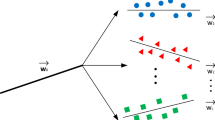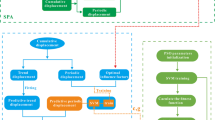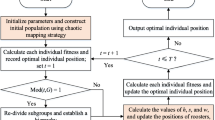Abstract
For landslide displacement, interval predictions are generally more realistic and reliable compared with traditional point predictions. This paper presents a new interval prediction method for landslide displacement integrating dual-output least squares support vector machine (DO-LSSVM) and particle swarm optimization (PSO) algorithms. In this new method, the PSO algorithm is employed to optimize coefficients of the least squares support vector machine (LSSVM) model for obtaining point prediction results, and the interval prediction of the landslide displacement is made based on the dual-outputs obtained from the DO-LSSVM model. To assess the rationality of the predictions, three performance evaluation indicators, including the prediction interval coverage probability (PICP), normalized mean prediction interval width (NMPIW), and coverage width-based criterion (CWC), are established. Case studies of the Tanjiahe landslide and the Baishuihe landslide in the Three Gorges Reservoir region are then used to demonstrate the effectiveness of the proposed method in predicting the landslide displacement interval. The case study results demonstrate that this new method has the best overall performance compared with other existing methods, and this new method can provide accurate and reliable results for the medium- to long-term interval prediction of landslide displacement.









Similar content being viewed by others
References
Borja RI, White JA (2010) Continuum deformation and stability analyses of a steep hillside slope under rainfall infiltration. Acta Geotech 5(1):1–14
Cai Z, Xu W, Meng Y, Shi C, Wang R (2016) Prediction of landslide displacement based on GA-LSSVM with multiple factors. Bull Eng Geol Env 75(2):637–646
Calvello M, Cascini L, Sorbino G (2008) A numerical procedure for predicting rainfall-induced movements of active landslides along pre-existing slip surfaces. Int J Numer Anal Meth Geomech 32(4):327–351
Chen L, Zhang W, Zheng Y, Gu D, Wang L (2020) Stability analysis and design charts for over-dip rock slope against bi-planar sliding. Eng Geol 275:105732
Chen W, Panahi M, Pourghasemi HR (2017) Performance evaluation of GIS-based new ensemble data mining techniques of adaptive neuro-fuzzy inference system (ANFIS) with genetic algorithm (GA), differential evolution (DE), and particle swarm optimization (PSO) for landslide spatial modelling. CATENA 157:310–324
Cheng Z, Gong W, Tang H, Juang CH, Deng Q, Chen J, Ye X (2021) UAV photogrammetry-based remote sensing and preliminary assessment of the behavior of a landslide in Guizhou, China. Eng Geol 106172
Corominas J, Moya J, Ledesma A, Lloret A, Gili JA (2005) Prediction of ground displacements and velocities from groundwater level changes at the Vallcebre landslide (Eastern Pyrenees, Spain). Landslides 2(2):83–96
Dai FC, Lee CF, Nagi YY (2002) Landslide risk assessment and management: an overview. Eng Geol 64(1):65–87
De Brabanter K, De Brabanter J, Suykens JA, De Moor B (2010) Approximate confidence and prediction intervals for least squares support vector regression. IEEE Trans Neural Networks 22(1):110–120
Domingos P (2012) A few useful things to know about machine learning. Commun ACM 55(10):78–87
Eubank RL, Speckman PL (1993) Confidence bands in nonparametric regression. J Am Stat Assoc 88(424):1287–1301
Gao X, Liu H, Zhang W, Wang W, Wang Z (2019) Influences of reservoir water level drawdown on slope stability and reliability analysis. Georisk: Assess Manag Risk Eng Syst Geohazards 13(2):145–153
Ge Q, Sun H, Liu Z, Yang B, Lacasse S, Nadim F (2021) A novel approach for displacement interval forecasting of landslides with step-like displacement pattern. Georisk: Assess Manage Risk Eng Syst Geohazards 1–15
Gong W, Juang CH, Wasowski J (2021) “Geohazards and human settlements: lessons learned from multiple relocation events in Badong, China—engineering geologist’s perspective. Eng Geol 285(7724):106051
Gong W, Zhao C, Juang CH, Tang H, Wang H, Hu X (2020) “Stratigraphic uncertainty modelling with random field approach. Comput Geotech 125:103681
Herrera G, Fernández-Merodo JA, Mulas J, Pastor M, Luzi G, Monserrat O (2009) A landslide forecasting model using ground based SAR data: the Portalet case study. Eng Geol 105(3–4):220–230
Helmstetter A, Sornette D, Grasso JR, Andersen JV, Gluzman S, and Pisarenko V (2004) Slider block friction model for landslides: application to Vaiont and La Clapiere landslides. J Geophys Res Solid Earth, 109(B2).
Huang F, Huang J, Jiang S, Zhou C (2017) Landslide displacement prediction based on multivariate chaotic model and extreme learning machine. Eng Geol 218:173–186
Knafl G, Sacks J, Ylvisaker D (1985) Confidence bands for regression functions. J Am Stat Assoc 80(391):683–691
Kennedy J, Eberhart R (1995) Particle swarm optimization. In: Proceedings of ICNN'95-international Conference on Neural Networks, Perth, Australia, pp 1942–1948
Khosravi A, Nahavandi S, Creighton D, Atiya AF (2010) Lower upper bound estimation method for construction of neural network-based prediction intervals. IEEE Trans Neural Networks 22(3):337–346
Loader C (2006) Local regression and likelihood. Springer, Berlin
Li R, Jin Y (2018) A wind speed interval prediction system based on multi-objective optimization for machine learning method. Appl Energy 228:2207–2220
Lian C, Zeng Z, Wang X, Yao W, Su Y, Tang H (2020) Landslide displacement interval prediction using lower upper bound estimation method with pre-trained random vector functional link network initialization. Neural Netw 130:286–296
Lian C, Zeng Z, Yao W, Tang H, Chen CLP (2016) Landslide displacement prediction with uncertainty based on neural networks with random hidden weights. IEEE Trans Neural Netw Learn Syst 27(12):2683–2695
Ma J, Tang H, Liu X, Hu X, Sun M, Song Y (2017) Establishment of a deformation forecasting model for a step-like landslide based on decision tree C5. 0 and two-step cluster algorithms: a case study in the Three Gorges Reservoir area, China. Landslides 14(3):1275–1281
Ma J, Tang H, Liu X, Wen T, Zhang J, Tan Q, Fan Z (2018) Probabilistic forecasting of landslide displacement accounting for epistemic uncertainty: a case study in the Three Gorges Reservoir area, China. Landslides 15(6):1145–1153
Miao F, Wu Y, Li L, Tang H, Xiong F (2019) Weakening laws of slip zone soils during wetting-drying cycles based on fractal theory: a case study in the Three Gorges Reservoir (China). Acta Geotech 15(7):1909–1923
Miao F, Wu Y, Xie Y, Li Y (2018) Prediction of landslide displacement with step-like behavior based on multialgorithm optimization and a support vector regression model. Landslides 15(3):475–488
Moayedi H, Mehrabi M, Mosallanezhad M, Rashid ASA, Pradhan B (2019) Modification of landslide susceptibility mapping using optimized PSO-ANN technique. Eng Comput 35(3):967–984
Pardo M, Sberveglieri G (2005) Classification of electronic nose data with support vector machines. Sens Actuators, B Chem 107(2):730–737
Quan H, Srinivasan D, Khosravi A (2014) Particle swarm optimization for construction of neural network-based prediction intervals. Neurocomputing 127:172–180
Rice SO (1939) The distribution of the maxima of a random curve. Am J Math 61(2):409–416
Saito M (1965). Forecasting the time of occurrence of a slope failure. In: Proceedings of the 6th International Conference on Soil Mechanics and Foundation Engineering, Montreal, pp. 537–541.
Sassa K, Picarelli L, Yueping Y (2009) Monitoring, prediction and early warning. In: Landslides-disaster risk reduction. Springer, Berlin
Shi Y, Eberhart RC (1999) Empirical study of particle swarm optimization. In: Proceedings of the 1999 Congress on Evolutionary Computation-CEC99 (Cat. No. 99TH8406), Washington, D.C., USA, pp 1945–1950
Shihabudheen KV, Pillai GN, Peethambaran B (2017) Prediction of landslide displacement with controlling factors using extreme learning adaptive neuro-fuzzy inference system (ELANFIS). Appl Soft Comput 61:892–904
Shrivastava NA, Khosravi A, Panigrahi BK (2015) Prediction interval estimation of electricity prices using PSO-tuned support vector machines. IEEE Trans Industr Inf 11(2):322–331
Suykens JA, Vandewalle J (1999) Least squares support vector machine classifiers. Neural Process Lett 9(3):293–300
Tang H, Wasowski J, Juang CH (2019) Geohazards in the three Gorges reservoir area, China-Lessons learned from decades of research. Eng Geol 261:105267
Wang JF (2003) Quantitative prediction of landslide using S-curve. China J Geol Hazard Control 14:1–8
Wang J, Wang S, Su A, Xiang W, Xiong C, and Blum P (2021) Simulating landslide-induced tsunamis in the Yangtze River at the Three Gorges in China. Acta Geotech 1–17.
Wang J, Xiang W, Lu N (2014) Landsliding triggered by reservoir operation: a general conceptual model with a case study at Three Gorges Reservoir. Acta Geotech 9(5):771–788
Wang L, Wu C, Li Y, Liu H, Zhang W, Chen X (2019) Probabilistic risk assessment of unsaturated slope failure considering spatial variability of hydraulic parameters. KSCE J Civ Eng 23(12):5032–5040
Wang Y, Tang H, Wen T, Ma J (2019) A hybrid intelligent approach for constructing landslide displacement prediction intervals. Appl Soft Comput 81:105506
Wang Y, Tang H, Wen T, Ma J (2020) Direct interval prediction of landslide displacements using least squares support vector machines. Complexity 2020:7082594
Wang Y, Tang H, Wen T, Ma J, Zou Z, Xiong C (2019) Point and interval predictions for Tanjiahe landslide displacement in the Three Gorges Reservoir Area, China. Geofluids 2019:8985325
Wen T, Tang H, Wang Y, Lin C, Xiong C (2017) Landslide displacement prediction using the GA-LSSVM model and time series analysis: a case study of Three Gorges Reservoir, China. Nat Hazard 17(12):2181–2198
Xing Y, Yue J, Chen C (2019) Interval estimation of landslide displacement prediction based on time series decomposition and long short-term memory network. IEEE Access 8:3187–3196
Xue X (2017) Prediction of slope stability based on hybrid PSO and LSSVM. J Comput Civ Eng 31(1):04016041
Yang B, Yin K, Lacasse S, Liu Z (2019) Time series analysis and long short-term memory neural network to predict landslide displacement. Landslides 16(4):677–694
Zhang J, Yin K, Wang J, Huang F (2015) Displacement prediction of baishuihe landslide based on time series and PSO-SVR model. Chin J Rock Mech Eng 34(2):382–391
Zhang W, Goh AT, Zhang Y (2015) Probabilistic assessment of serviceability limit state of diaphragm walls for braced excavation in clays. ASCE-ASME J Risk Uncertain Eng Syst Part A Civil Eng 1(3):06015001
Zhang W, Niu P, Li G, Li P (2013) Forecasting of turbine heat rate with online least squares support vector machine based on gravitational search algorithm. Knowl-Based Syst 39:34–44
Zhang W, Tang L, Li H, Wang L, Cheng L, Zhou T, Chen X (2020) Probabilistic stability analysis of Bazimen landslide with monitored rainfall data and water level fluctuations in Three Gorges Reservoir, China. Front Struct Civ Eng 14(5):1247–1261
Zhang W, Wu C, Zhong H, Li Y, Wang L (2021) Prediction of undrained shear strength using extreme gradient boosting and random forest based on Bayesian optimization. Geosci Front 12(1):469–477
Zhou C, Yin K, Cao Y, Ahmed B (2016) Application of time series analysis and PSO-SVM model in predicting the Bazimen landslide in the Three Gorges Reservoir, China. Eng Geol 204:108–120
Acknowledgements
The financial support provided by the Major Program of National Natural Science Foundation of China (No. 42090055), the National Natural Science Foundation of China (No. 41977242), and the Fundamental Research Funds for the Central Universities, China University of Geosciences (Wuhan) (No. CUGGC09) is acknowledged.
Author information
Authors and Affiliations
Corresponding author
Additional information
Publisher's Note
Springer Nature remains neutral with regard to jurisdictional claims in published maps and institutional affiliations.
Rights and permissions
About this article
Cite this article
Gong, W., Tian, S., Wang, L. et al. Interval prediction of landslide displacement with dual-output least squares support vector machine and particle swarm optimization algorithms. Acta Geotech. 17, 4013–4031 (2022). https://doi.org/10.1007/s11440-022-01455-2
Received:
Accepted:
Published:
Issue Date:
DOI: https://doi.org/10.1007/s11440-022-01455-2




